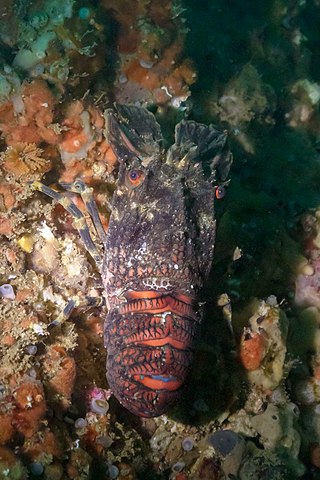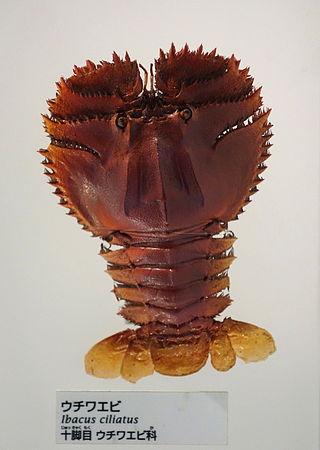
Lobsters are widely fished around the world for their meat. They are often hard to catch in large numbers, but their large size can make them a profitable catch. Although the majority of the targeted species are tropical, the majority of the global catch is in temperate waters.

Slipper lobsters are a family (Scyllaridae) of about 90 species of achelate crustaceans, in the Decapoda clade Reptantia, found in all warm oceans and seas. They are not true lobsters, but are more closely related to spiny lobsters and furry lobsters. Slipper lobsters are instantly recognisable by their enlarged antennae, which project forward from the head as wide plates. All the species of slipper lobsters are edible, and some, such as the Moreton Bay bug and the Balmain bug are of commercial importance.

Ibacus peronii, the Balmain bug or butterfly fan lobster, is a species of slipper lobster. It lives in shallow waters around Australia and is the subject of small-scale fishery. It is a flattened, reddish brown animal, up to 23 cm (9 in) long and 14 cm (6 in) wide, with flattened antennae and no claws.
Metanephrops binghami, the Caribbean lobster or Caribbean lobsterette, is a lobster which inhabits the western Atlantic region: from the Bahamas and southern Florida to French Guiana, including the Gulf of Mexico and the Caribbean Sea.

The Japanese spiny lobster, Panulirus japonicus, is a member of the genus Panulirus of spiny lobsters. It grows up to 30 centimetres (12 in) long and lives in the Pacific Ocean around Japan, Taiwan, China, and Korea. P. japonicus is the subject of commercial lobster fishery in Japan. It is a popular item in high-class Japanese cuisine. Serving and preparation methods include sashimi, as a steak, frying, and roasting alive.
Metanephrops boschmai, known as the Bight lobster, Bight scampi or Boschma's scampi, is a species of lobster endemic to Western Australia.

Scyllarus arctus is a species of slipper lobster which lives in the Mediterranean Sea and eastern Atlantic Ocean. It is uncommon in British and Irish waters, but a number of English-language vernacular names have been applied, including small European locust lobster, lesser slipper lobster and broad lobster.

Nephropsis rosea, sometimes called the rosy lobsterette or two-toned lobsterette, is a species of lobster.

Scyllarides latus, the Mediterranean slipper lobster, is a species of slipper lobster found in the Mediterranean Sea and in the eastern Atlantic Ocean. It is edible and highly regarded as food, but is now rare over much of its range due to overfishing. Adults may grow to 1 foot (30 cm) long, are camouflaged, and have no claws. They are nocturnal, emerging from caves and other shelters during the night to feed on molluscs. As well as being eaten by humans, S. latus is also preyed upon by a variety of bony fish. Its closest relative is S. herklotsii, which occurs off the Atlantic coast of West Africa; other species of Scyllarides occur in the western Atlantic Ocean and the Indo-Pacific. The larvae and young animals are largely unknown.

Scyllarides is a genus of slipper lobsters.
Scyllarides herklotsii is a species of slipper lobster from the Atlantic coast West Africa. It is edible, but is not commercially fished, and is taken only by accident.
Eunephrops manningi, the banded lobster, is a species of lobster found in the West Indies. It was named in 1974 by carcinologist Lipke Holthuis after his friend and fellow carcinologist Raymond B. Manning.
Eunephrops is a genus of lobsters, containing four species, all found in the Western Atlantic Ocean:

Scyllarus is a genus of slipper lobsters from the Atlantic Ocean, including the Mediterranean and Caribbean. Until 2002, the genus included far more species, but these are now placed in other genera. The following species remain in Scyllarus:
Arctides guineensis is a species of slipper lobster that lives in the Bermuda Triangle. It is known in Bermuda as the small Spanish lobster, a name which is also favoured by the FAO.

Palinurus mauritanicus is a species of spiny lobster. It is found in deep waters in the eastern Atlantic Ocean and the western Mediterranean Sea.
Scyllarus pygmaeus is a species of slipper lobster that lives in shallow water in the Mediterranean Sea and eastern Atlantic Ocean. It grows to a length of 55 mm (2.2 in), which is too small for it to be fished for food. The juvenile form was first described in 1885, with the description of the adult following in 1888 as a result of the Challenger expedition.

Parribacus antarcticus is a species of slipper lobster. Its common names include "sculptured mitten lobster" and "sculptured slipper lobster" in English, and ula-pehu and ula-pápapa in Hawaiian.

Ibacus ciliatus is a species of slipper lobster from the north-west Pacific Ocean.
Scyllarides haanii, the Aesop slipper lobster, is a marine decapod crustean in the family Scyllaridae. Other common names include the humpbacked slipper lobster and the ridgeback slipper lobster.











